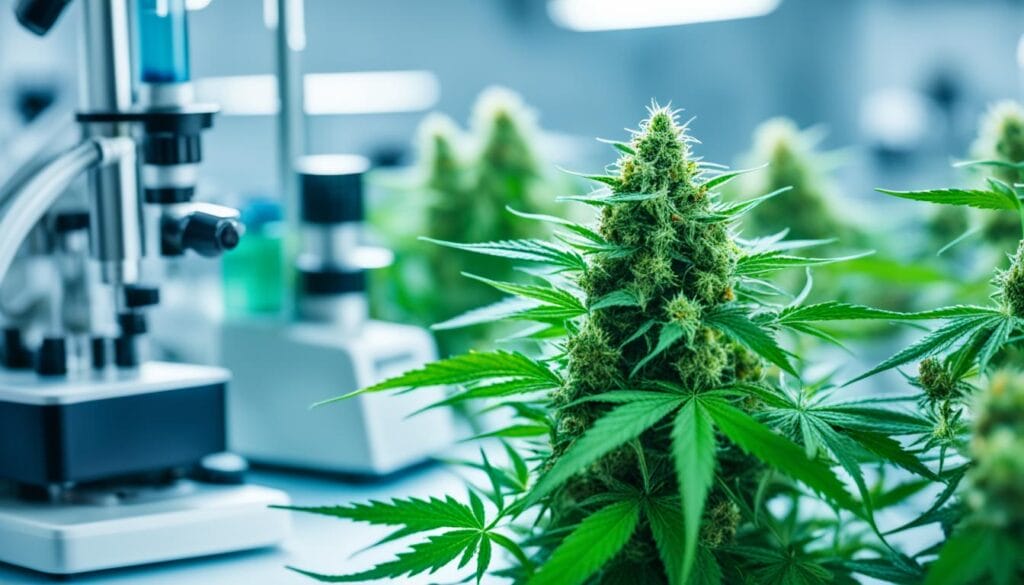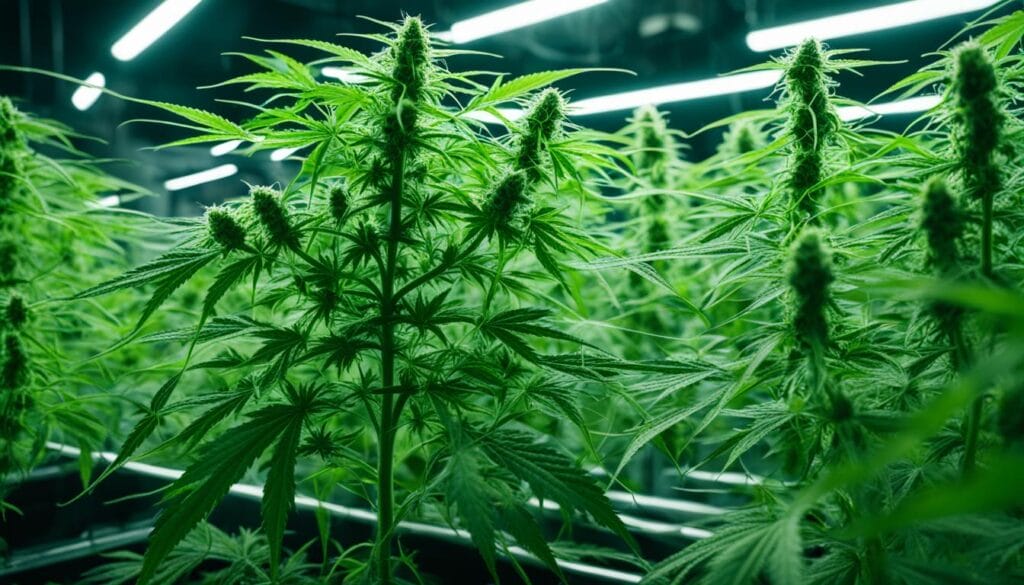Unveiling the Evolution of Feminized Cannabis Genetics

It may come as a surprise to learn that over 90% of cannabis growers opt for feminized seeds in their operations, a testament to the groundbreaking evolution of feminized cannabis genetics. This seismic shift is not just a trend; it’s a cannabis cultivation revolution brought forth by advanced breeding techniques. As we trace the journey from the early days of selective breeding to the sophisticated genetic manipulation of today, we will unveil the story behind feminized cannabis plants and the innovation that has made them a staple in horticulture.
Key Takeaways
- The significant preference for feminized seeds among growers.
- How feminized genetics have revolutionized cannabis cultivation.
- Understanding the advanced breeding techniques behind the revolution.
- Insight into the historical development of feminized cannabis strains.
- Appreciating the innovation and technological leaps in cannabis genetics.
The Genesis of Cannabis Cultivation and Feminized Genetics
The rich tapestry of cannabis cultivation has evolved significantly over the centuries. Integral to this development has been the understanding and application of feminized genetics. With the shifting tides of agricultural practices and market demands, a deep dive into the biological foundation and economic implications of these genetic advances is both fascinating and necessary.
Understanding Dioecy in Cannabis Sativa L.
In the realm of botany, dioecy in cannabis refers to the species Cannabis Sativa L. being naturally dioecious, meaning it typically produces distinct male and female plants. This trait poses unique challenges and opportunities for cultivators aiming to harness specific plant qualities. By prioritizing female plants, known for their cannabinoid-rich flowers, growers can maximize the potency and yield of their harvests.
The Commercial Need for Feminized Cannabis Plants
The advent of feminized genetics has been a game-changer in cannabis production. Unlike their male counterparts, feminized plants ensure a crop that is almost entirely comprised of flowering females. This uniformity is not just a matter of convenience; it represents the agricultural and economic shift towards efficiency and consistency, caters to the market’s preference for seedless buds, and saves growers the labor of identifying and removing males.
Early Observations of Hermaphroditism in Cultivation
While controversial, hermaphroditism in cultivation has played a pivotal role in the development of feminized strains. Early cultivators observed the phenomenon of cannabis plants presenting both male and female flowers under certain circumstances. These observations spurred a scientific curiosity that ultimately led to sophisticated breeding techniques. Understanding hermaphroditism has been a cornerstone for developing seed varieties that dramatically reduce or eliminate the presence of male plants, setting a new standard in cannabis cultivation.
Identifying the Significance of Hermaphroditic Cannabis Inflorescences
In the realm of cannabis cultivation, hermaphroditic cannabis inflorescences stand as a curious and pivotal point of discussion. Characterized by the presence of both male and female reproductive organs within a single flower, these hermaphroditic structures are more than mere botanical anomalies. They hold significant relevance to cannabis reproduction and seed production,-underpinning strategies that ensure prolific yields and quality in cannabis genetics.
Essentially, cannabis plants can be dioecious or monoecious, but it’s the hermaphroditism in cannabis that captures our attention. If left unchecked, hermaphroditic traits can lead to a mixed harvest, affecting the uniformity of seed production. However, when harnessed correctly, these traits become invaluable, as they enable growers to produce feminized seeds—a coveted commodity in the industry.
Hermaphroditic cannabis bears witness to nature’s adaptability, echoing an intrinsic survival mechanism that could tip the scales in cultivation practices when understood and utilized effectively.
Why do hermaphroditic cannabis inflorescences matter in the production sphere? They are at the forefront of our ability to produce those sought-after feminized seeds. Through selective breeding and careful environmental controls, cultivators can encourage the development of hermaphroditic traits to ensure that nearly all plants in a crop contribute to seed production.
- Unveiling the dynamic roles of hermaphroditism helps us to control and refine cannabis reproduction.
- Strategic intervention in seed production leads to higher consistency in crop results.
- Understanding hermaphroditism is key to reducing the unpredictability in cannabis crops.
As we continue to delve into the myriad facets of cannabis cultivation, keen attention to hermaphroditic inflorescences becomes indispensable. Their study and application not only enrich our botanical knowledge but also align us more closely with the ever-evolving paradigms of cannabis horticulture.
Genetic Markers and Sex Determination in Cannabis
Advancements in cannabis research have revealed the intricacies of genetic markers and their crucial role in sex determination in cannabis. The introduction of molecular biology into plant breeding programs has been a game-changer for cultivators and geneticists alike. By decoding the structure and mechanisms behind cannabis chromosomes, researchers can now predict and influence sex expression in cannabis plants with greater accuracy.
Decoding Cannabis Chromosomes
The journey to understanding sex determination within the realm of cannabis begins deep within its genetic blueprint. Cannabis chromosomes, specifically, have become a focal point of research. These microscopic structures carry the genetic information necessary for the differentiation of male and female plants.
Each cannabis plant has two sets of chromosomes, one inherited from each parent. Within these sets lies the potential for varied sex expression, a crucial factor for breeders focusing on developing strains with specific characteristics. Scientific exploration into these genetic segments has massively impacted plant breeding practices.
Sex Expression and Molecular Markers in Plant Breeding
It is within the realm of plant breeding that sex expression takes on significant importance. Traditional breeding methods relied heavily on phenotypic observations, which can be time-consuming and less precise. The use of genetic markers, however, offers a more efficient pathway to select for desirable traits, including the sex of the plant.
| Characteristic | Genetic Markers | Benefits in Plant Breeding |
|---|---|---|
| Sex Determination | Y or X chromosome-linked markers | Allows for early identification and selection of female plants |
| Resistance Traits | Markers linked to pathogen resistance genes | Enables development of disease-resistant strains |
| Yield and Quality | Quantitative trait loci (QTLs) markers | Assists in enhancing yield and cannabinoid profiles |
As this table illustrates, the practice of integrating molecular markers into cannabis plant breeding is transformative, dictating not just sex, but also a wide spectrum of other desirable attributes. The upshot is a level of precision breeding previously unattainable, paving the way for the development of bespoke cannabis varieties that cater to specific medicinal or recreational needs.
Cannabis Breeding Techniques and the Rise of Feminized Seeds
The transformative wave of feminized seeds in cannabis culture is a direct result of innovative cannabis breeding techniques. These techniques are not only responsible for the substantial rise of feminized seeds but are also shaping the future of cannabis farming efficiency. A key method in this transformative process is inducing hermaphroditism in plants to ensure a bountiful yield of feminized seeds, steering clear of the reliance on natural pollination which can result in mixed seed populations.
Inducing Hermaphroditism: Methods and Implications
To induce hermaphroditism, growers employ multiple stresses or chemical treatments on female cannabis plants. This intentional shift leverages the natural survival mechanisms within the plant, causing it to produce male flowers alongside female ones—thus creating hermaphrodite plants. These self-pollinating plants can generate seeds that are nearly identical genetically to the self-pollinated female plant, which are known as feminized seeds. However, this method requires precision to prevent the development of unwanted hermaphroditic traits in future generations.

From Hermaphrodite Plants to Feminized Seeds
The transition from hermaphrodite plants to feminized seeds is pivotal for cannabis breeders focusing on consistency and quality in their crops. Achieving a strong population of female plants maximizes overall cannabinoid production, as female plants are the ones responsible for creating the trichome-rich flowers desired by consumers and medical patients alike. However, ensuring the stability of these seeds is a subtle art, as breeders must navigate potential issues such as genetic drift that may emerge from continuous inbreeding.
| Technique | Stress Induced | Chemical Used | Potential Yield Increase (%) |
|---|---|---|---|
| Light Cycle Interruption | Yes | None | 0-5 |
| Temperature Fluctuation | Yes | None | 5-10 |
| Chemical Treatment | No | Colloidal Silver or STS | Up to 90 |
It’s crucial for growers to understand the complexities of cannabis breeding techniques as they nurture feminized seeds for future harvests. As the marketplace continues to expand with a demand for gender-specific seeds, mastering the delicate process of inducing hermaphroditism with precision is the key for breeding success and the continued rise of specialized cannabis genetics.
Evolution of Feminized Cannabis Genetics
The evolution of feminized cannabis genetics represents a significant milestone in the cannabis industry. Over time, advanced breeding techniques have paved the way for the creation of strains that not only foster ease of cultivation but also ensure genetic stability. These developments have transformed cannabis production, making it more efficient and predictable, especially for those seeking to achieve specific therapeutic or recreational effects.
Understanding the evolution is crucial to appreciating the scientific breakthroughs and the meticulous selection processes essential for producing these stable feminized strains. Historically, cultivators would face a significant challenge in ensuring a crop free of male plants, which are generally unfavorable for cannabinoid production. The introduction of feminized cannabis seeds virtually eliminated this issue, revolutionizing cannabis cultivation practices worldwide.
Advanced breeding techniques, such as the use of silver thiosulphate or colloidal silver to induce female plants to produce pollen, have been instrumental in advancing the genetic stability of feminized cannabis strains.
Today’s successful feminization processes reflect the rigorous standards and complex scientific understanding that breeders integrate into their work. Genetic markers have been identified that screen for the desired feminized trait, adding a layer of precision that was previously unattainable. This meticulous attention to detail extends to every stage of the breeding process, ensuring that the feminized seeds produced will lead to robust and genetically stable cannabis plants.
- Isolation of superior genetic lines for breeding
- Stress tests to determine plant resilience and trait inheritance
- Accurate documentation of phenotypic expressions in progeny
The ongoing research into these areas not only bolsters our grasp of cannabis science but also raises the bar for the entire agronomic community. As feminized cannabis genetics continue to evolve, the horizons of what can be achieved through cultivation expand, heralding a new era of precision and possibility in cannabis and agricultural science alike.
Exploring Phytohormones and Environmental Factors Influencing Cannabis Genetics
The intricate dance between phytohormones and various environmental factors plays a significant role in the expression of cannabis genetics. These elements work in concert, acting as vital contributors to the gender manifestation and plant sex determination in cannabis, effects that hold considerable value for cultivators aiming to optimize their yields.

Epigenetic Factors in Gender Manifestation
Epigenetic factors significantly influence the manifestation of gender traits in cannabis plants. Through a complex interaction with environmental signals, these factors can activate or silence specific genes responsible for gender expression. Such responsiveness to the environment ensures cannabis plants exhibit a remarkable level of adaptability and resiliency.
The Role of Phytohormones in Plant Sex Determination
At the heart of plant sex determination lies a group of powerful organic compounds known as phytohormones. These chemical messengers are crucial for signaling and orchestrating the developmental processes that lead to male or female phenotypes in cannabis plants.
| Phytohormone | Function in Sex Determination | Impact on Cannabis Genetics |
|---|---|---|
| Auxins | Promotes female characteristics | Influences the development of female plant structures |
| Cytokinins | Encourages cell division and growth | May impact the vigor of either male or female plants |
| Gibberellins | Associated with male characteristics | High levels can induce male flowers in genetically female plants |
| Ethylene | Can promote female flowering in dioecious plants | Fosters the development of female flowers, important for seedless production |
Understanding the shared relationship between phytohormones, environmental factors, and genetic expression is key to mastering cannabis cultivation; it enables breeders and growers not only to predict but also potentially control the sexual phenotype of their cannabis crops with greater precision.
Advancements in Plant Genetics Research and Cannabis
The intersection of plant genetics research and cannabis cultivation has been an area of intense scientific inquiry and innovation. With the integration of molecular biology, novel methods are reshaping the landscape of cannabis genetics, leading to significant breakthroughs in seed production and cultivar development.
Contributions of Molecular Biology to Cannabis Cultivation
Molecular biology has played a pivotal role in unveiling the intricate blueprints of cannabis genetics. Key insights into the plant’s DNA have not only clarified the pathway for cannabis cultivation advancements, but also fostered new strategies for selective breeding and genetic preservation.
Modern Approaches to Cannabis Genetics and Seed Production
Current trends in plant genetics research are emphasizing the importance of sustainable and efficient seed production. Modern approaches leverage genomic data to optimize breeding programs, culminating in superior cannabis strains that offer consistency, versatility, and resilience.
| Technique | Impact on Seed Production | Benefits to Cultivation |
|---|---|---|
| Marker-Assisted Selection | Enhances the success rate of developing desired traits | Facilitates the cultivation of plants with optimized cannabinoid profiles |
| Crispr-Cas9 Gene Editing | Enables precise alterations in the plant genome | Reduces time needed to produce new cannabis varieties |
| High-Throughput Sequencing | Accelerates identification of genetic markers | Improves understanding of the genetic basis for stress resistance |
Hybrid Cannabis Strains: Combining the Best of Genetics
The cultivation landscape has been significantly transformed with the rise of hybrid cannabis strains, masterfully combining genetic profiles to harness desired traits such as aroma, potency, and crop yield. These sophisticated strains emerge from meticulous breeding protocols that aim to infuse genetic variation and genetic stability into the gene pool. Let’s delve into the multilayered impacts of these hybrids and the science that stabilizes their coveted characteristics.
The Impact of Hybrids on Genetic Variation
Hybrids are the progeny of two genetically different strains of cannabis, introducing a level of genetic variation that expands the possibilities of plant characteristics. By blending the best attributes of Indica and Sativa varieties, breeders are able to produce strains tailored to specific therapeutic and recreational needs. This genetic diversity not only caters to consumer preferences but also contributes to the resilience and adaptability of the crop in varying environmental conditions.
Breeding Protocols for Stabilizing Desired Traits
To ensure that hybrid cannabis strains consistently express desired traits, breeders follow rigorous breeding protocols. These protocols involve selective breeding, backcrossing, and sometimes marker-assisted selection to consolidate the genetic expression of traits such as resistance to pests, cannabinoid profiles, or flowering times. By understanding and manipulating genetic inheritance patterns, breeders can predict the outcome of hybrid strains with greater accuracy.
Below is an illustrative table detailing the desired traits often targeted in hybrid cannabis breeding and the corresponding techniques used to stabilize them:
| Desired Trait | Breeding Technique | Expected Outcome |
|---|---|---|
| High THC Concentration | Backcrossing | Consistent psychoactive effects |
| Disease Resistance | Selection and Hybridization | Robust plants with reduced need for pesticides |
| Short Flowering Time | Marker-Assisted Selection | Efficient cultivation cycles |
| Unique Flavor Profile | Phenotypic Selection | Appealing taste and aroma |
The judicious deployment of these breeding protocols ensures that hybrid cannabis strains can consistently deliver the quality and experience demanded by enthusiasts and patients alike, establishing a benchmark in cannabis genetics that attracts both novice and connoisseur.
Protecting Cannabis Biodiversity Through Genetic Conservation
The vibrant tapestry of cannabis biodiversity is at risk, highlighting the necessity for genetic conservation. The preservation of genetic diversity within cannabis species not only maintains the plant’s robustness against disease and environmental changes but also ensures that future generations have access to a broad genetic repository for research and cultivation.
The Dilemma of Genetic Drift and Bottlenecks
Cannabis genetics face the threat of genetic drift and bottlenecks. Genetic drift, a mechanism of evolution, can cause rare alleles to disappear from a population, reducing genetic variation. In cannabis, this may result in a loss of unique traits or resilience in certain strains. Bottlenecks, a drastic reduction in population size and genetic diversity, often occur due to habitat destruction, overharvesting, or disease outbreaks.
Conservation Strategies for Cannabis Landraces
Effective conservation strategies are paramount for protecting cannabis landraces, which are vital repositories of unique genetic codes. These strategies include both in-situ and ex-situ approaches, aiming to preserve the genetic integrity and prevent the loss of valuable genetic traits.
| In-Situ Conservation | Ex-Situ Conservation |
|---|---|
| Natural habitat protection | Seed banks |
| Farmers’ cooperatives conserving heirloom varieties | Clone archives |
| Community-led breeding programs | Tissue culture repositories |
| Legal frameworks supporting native strains | Botanical gardens and living collections |
By supporting these varied approaches, we can take significant strides in maintaining the cannabis biodiversity necessary for sustainable cultivation and robust genetic profiles. This focused commitment to genetic conservation will benefit the industry and enthusiasts alike, safeguarding the rich variety of cannabis strains for future innovation and enjoyment.
Conclusion
In a journey through the past, present, and future of cannabis cultivation, we have unearthed the remarkable advances in plant breeding that led to the advent of feminized cannabis genetics. The summary of our exploration reveals the intricate dance between science and nature, where advanced breeding techniques play a pivotal role in refining and securing genetically stable feminized strains. This evolution is more than just change; it’s a revolution that has reshaped the landscape of cannabis cultivation.
With the knowledge garnered on the genesis and development of feminized genetics, we have a broader understanding of the complexities involved in cannabis breeding—from the identification of hermaphroditic cannabis inflorescences to the critical role of phytohormones and environmental factors. By examining the very chromosomes that dictate cannabis sex determination and the subsequent emergence of hybrids that combine the best of genetics, the article has presented key takeaways for enthusiasts and professionals alike.
The tapestry woven in this article portrays the transformative power of genetic conservation strategies to protect cannabis biodiversity and the significance of this cultivation revolution. In summary, the evolution of feminized cannabis genetics and the technological feats accomplished through molecular biology and epigenetics have propelled the cannabis industry forward, promising a wider array of reliable, consistent, and dynamic feminized strains for a rapidly growing market.
FAQ
What is the evolution of feminized cannabis genetics?
The evolution of feminized cannabis genetics refers to the advancements in breeding techniques that have led to the development of stable and reliable feminized cannabis strains. These advancements have revolutionized cannabis cultivation, allowing for the production of plants that predominantly exhibit female characteristics.
What is dioecy in Cannabis Sativa L.?
Dioecy in Cannabis Sativa L. refers to the existence of separate male and female plants. In this species, the male plants produce pollen, while the female plants produce flowers that can be pollinated to produce seeds. The development of feminized cannabis genetics aims to eliminate the male plants and ensure a higher yield of female plants.
Why is there a commercial need for feminized cannabis plants?
The commercial need for feminized cannabis plants stems from the fact that female cannabis plants are the primary source of marijuana flowers, which contain the cannabinoids sought after by consumers. By eliminating the male plants, growers can maximize their yield and produce high-quality cannabis flowers.
What were the early observations of hermaphroditism in cultivation?
Early observations of hermaphroditism in cannabis cultivation involved the discovery that some plants exhibited both male and female reproductive organs. This discovery led to the understanding that cannabis plants can self-pollinate under certain conditions, potentially resulting in the production of seeds. These early observations laid the foundation for the development of feminized cannabis genetics.
Why are hermaphroditic cannabis inflorescences significant?
Hermaphroditic cannabis inflorescences play a role in cannabis reproduction and seed production. These plants have both male and female reproductive organs, allowing them to self-pollinate and produce seeds without the need for external pollen. Understanding the mechanisms and implications of hermaphroditism in cannabis cultivation is crucial for developing strategies to ensure stable and consistent feminized seed production.
How do genetic markers and chromosomes determine the sex of cannabis plants?
Genetic markers and chromosomes play a crucial role in determining the sex of cannabis plants. The presence or absence of specific genes on certain chromosomes determines whether a plant will develop as male or female. By using molecular markers, breeders can identify and select for desired sex traits in cannabis during the plant breeding process.
What are the breeding techniques used to produce feminized cannabis seeds?
Breeding techniques used to produce feminized cannabis seeds involve inducing hermaphroditism in cannabis plants. This can be done through various methods, such as stressing the plants or treating them with chemicals. By inducing hermaphroditism, breeders can ensure that the resulting seeds will predominantly produce female plants, thus creating a reliable source of feminized cannabis genetics.
How have advancements in breeding techniques contributed to the evolution of feminized cannabis genetics?
Advancements in breeding techniques such as inducing hermaphroditism and selecting for desired sex traits have contributed to the evolution of feminized cannabis genetics. These techniques have led to the development of increasingly stable and reliable feminized cannabis strains, allowing growers to consistently produce high-quality marijuana flowers.
How do phytohormones and environmental factors influence cannabis genetics?
Phytohormones and environmental factors play a crucial role in influencing cannabis genetics. Epigenetic factors, such as temperature and light exposure, can affect gender manifestation in cannabis plants. Phytohormones, including auxins and gibberellins, are involved in plant sex determination. Understanding these factors is vital for manipulating cannabis genetics and optimizing cultivation practices.
What is the contribution of plant genetics research to cannabis cultivation?
Plant genetics research has made significant contributions to cannabis cultivation. Through molecular biology techniques, researchers have gained a deeper understanding of cannabis genetics and the factors influencing plant traits. This knowledge has led to the development of modern approaches to cannabis genetics and seed production, allowing for the creation of superior cannabis strains.
What are hybrid cannabis strains, and how do they impact genetic variation?
Hybrid cannabis strains are created by crossing two or more genetically diverse parent plants. The combination of different genetic traits in hybrids results in increased genetic variation, allowing breeders to select for desirable characteristics. This has led to the development of new and improved cannabis strains that exhibit a wide range of traits and characteristics.
How can cannabis biodiversity be protected through genetic conservation?
Cannabis biodiversity can be protected through genetic conservation efforts. Genetic drift and bottlenecks pose challenges to maintaining genetic diversity in cannabis populations, but conservation strategies such as preserving landraces and utilizing seed banks can help preserve unique and valuable cannabis genetics for future generations.
Suggested Articles
;)
;)
;)




 22 Jun 2025
22 Jun 2025  19 min read
19 min read


 June 22, 2025
June 22, 2025 


RESPONSES (0)
No responses yet. Be the first to respond!